-
current
recommendations- Liefdefjord
New page dedicated to one of Spitsbergen's most beautiful fjords. Background information and many photos.
- New Spitsbergen guidebook
The new edition of my Spitsbergen guidebook is out and available now!
- Liefdefjord
New page dedicated to one of Spitsbergen's most beautiful fjords. Background information and many photos.
Page Structure
-
Spitsbergen-News
- Select Month
- June 2025
- May 2025
- April 2025
- March 2025
- February 2025
- January 2025
- December 2024
- November 2024
- October 2024
- September 2024
- August 2024
- July 2024
- June 2024
- May 2024
- April 2024
- March 2024
- February 2024
- January 2024
- December 2023
- November 2023
- October 2023
- September 2023
- August 2023
- July 2023
- June 2023
- May 2023
- April 2023
- March 2023
- February 2023
- January 2023
- December 2022
- November 2022
- October 2022
- September 2022
- August 2022
- July 2022
- June 2022
- May 2022
- April 2022
- March 2022
- February 2022
- January 2022
- December 2021
- November 2021
- October 2021
- September 2021
- August 2021
- July 2021
- June 2021
- May 2021
- April 2021
- March 2021
- February 2021
- January 2021
- December 2020
- November 2020
- October 2020
- September 2020
- August 2020
- July 2020
- June 2020
- May 2020
- April 2020
- March 2020
- February 2020
- January 2020
- December 2019
- November 2019
- October 2019
- September 2019
- August 2019
- July 2019
- June 2019
- May 2019
- April 2019
- March 2019
- February 2019
- January 2019
- December 2018
- November 2018
- October 2018
- September 2018
- August 2018
- July 2018
- June 2018
- May 2018
- April 2018
- March 2018
- February 2018
- January 2018
- December 2017
- November 2017
- October 2017
- September 2017
- August 2017
- July 2017
- June 2017
- May 2017
- April 2017
- March 2017
- February 2017
- January 2017
- December 2016
- November 2016
- October 2016
- September 2016
- August 2016
- July 2016
- June 2016
- May 2016
- April 2016
- March 2016
- February 2016
- January 2016
- December 2015
- November 2015
- October 2015
- September 2015
- August 2015
- July 2015
- June 2015
- May 2015
- April 2015
- March 2015
- February 2015
- January 2015
- December 2014
- November 2014
- October 2014
- September 2014
- August 2014
- July 2014
- June 2014
- May 2014
- April 2014
- March 2014
- February 2014
- January 2014
- December 2013
- November 2013
- October 2013
- September 2013
- August 2013
- July 2013
- June 2013
- May 2013
- April 2013
- March 2013
- February 2013
- January 2013
- December 2012
- November 2012
- October 2012
- September 2012
- August 2012
- July 2012
- June 2012
- May 2012
- April 2012
- March 2012
- February 2012
- January 2012
- December 2011
- November 2011
- October 2011
- September 2011
- August 2011
- May 2011
- April 2011
- March 2011
- February 2011
- January 2011
- December 2010
- November 2010
- September 2010
- August 2010
- July 2010
- June 2010
- May 2010
- April 2010
- March 2010
- February 2010
- November 2009
- October 2009
- August 2009
- July 2009
- June 2009
- May 2009
- April 2009
- March 2009
- February 2009
- January 2009
- December 2008
- November 2008
- October 2008
- August 2008
- July 2008
- June 2008
- May 2008
- April 2008
- March 2008
- February 2008
- April 2000
- Select Month
-
weather information
-
Newsletter

| Guidebook: Spitsbergen-Svalbard |
Home
→ May, 2019
Monthly Archives: May 2019 − News & Stories
Spitsbergen under sail 2019 and Rolf’s arctic blog starting now
The arctic summer season “Spitsbergen under sail” is starting tomorrow (Saturday) with sV Antigua: we are starting our first departure in Longyearbyen – arctic spring/early summer. Exploring stunning landscapes, ice and snow and the arctic wildlife under sail!
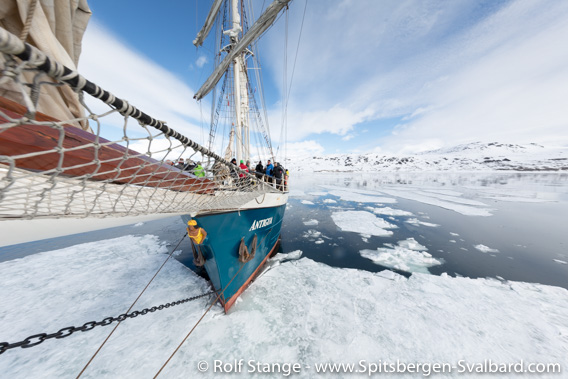
Spitsbergen under sail: with SV Antigua to the ice.
And this means of course that my arctic blog on exactly this page will be updated again regularly, and it is absolutely worth coming back and checking for new photos and short stories. Join us online when we explore remote arctic fjords and islands and meet the wildlife! We will explore Spitsbergen several times under sail with SV Antigua, but also with the smaller SY Arctica II and we will also venture to Greenland with the good SY Anne-Margaretha.
And if you want to join us in real life – the voyage descriptions for 2020 are now online! (German only, sorry, but that is the board language on these trips).
Polar bear close to Longyearbyen
A polar bear was seen close to Longyearbyen near 5 a.m. on Monday (27 May) morning. It was in Adventdalen, not far from the road and the lowermost houses. The Sysselmannen (police) was called, several shots were fired with a flare gun and the helicopter went out to scare the bear away from Longyearbyen. The bear then walked away along the shore towards Hiorthhamn, on the other side of Adventfjord.
The public is reminded to take the risk of meeting a polar bear seriously also near Longyearbyen.
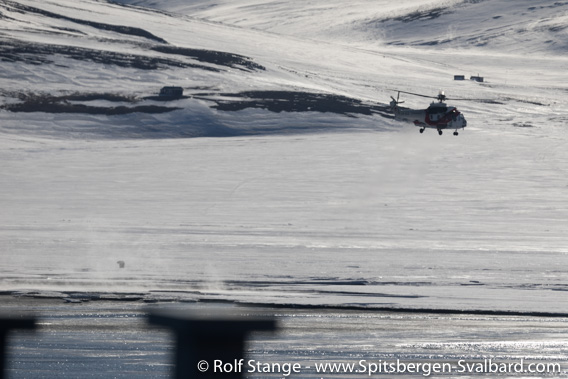
The Sysselmannen’s helicopter and the polar bear (lower left) in Adventdalen.
Geese arrived in Spitsbergen after spring migration
Sun
26 May
2019
Spring has also arrived in arctic Spitsbergen. Early migrating birds such as the snow bunting and Little auk came already more than a month ago in April, filling the tundra in and around Longyearbyen respectively the mountain slopes with their singing (snow bunting) and crazy laughter (snow bunting).
Temperatures are still cold, mild frost, but the snow-free tundra patches are growing every day and the rivers show signs of breaking up.

Tundra is coming through the snow in Adventdalen.
By now, most migrating birds have returned to their summer territories. A good week ago, the first Pink-footed geese were suddenly sitting, well camouflaged, on the tundra next to the roads in Longyearbyen, and the first Barnacle geese followed soon.
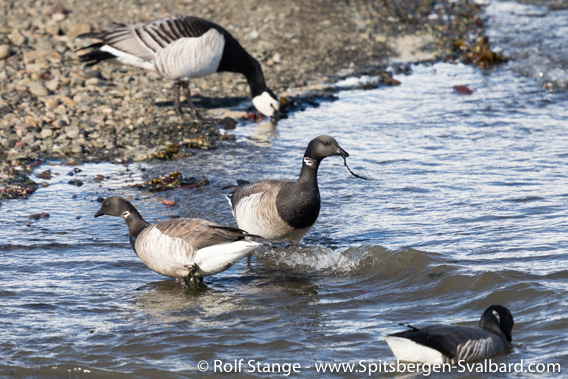
Brent geese on the shore of Adventfjord (a Barnacle goose in the background).
Once the first geese had arrived, dozens and hundreds followed during the next couple of days to settle down on snow-free tundra areas in Adventdalen and even within Longyearbyen. In this area, the snow melt starts regularly a couple of weeks early than elsewhere in Spitsbergen, making the tundra areas here an important resting area for many birds, which feed on tundra vegetation, after their spring migration. Later they will disperse to their various breeding areas within the region.
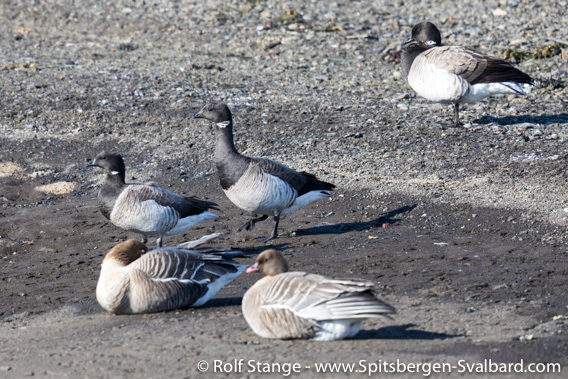
Brent geese on the shore of Adventfjord (Pink-footed geese in the foreground).
Currently, it is very easy to observe all geese species that breed in Spitsbergen as well as Common eider ducks, King eider and many otehr species very close to or even within Longyearbyen. Soon they will move to more inaccessible areas and then most of them will also be very shy. Then, it will be much more difficult, if not impossible, to secure good observations and photos, even with good equipment.
Especially the Brent goose is a difficult species to observe. It is not an everyday sight during the summer and observations are usually from a greater distance. So it is a special pleasure to see this species on a short distance on the shore of Adventfjord just next to Longyearbyen. As long as you stay a bit hidden or within a car, the risk of disturbance is low.
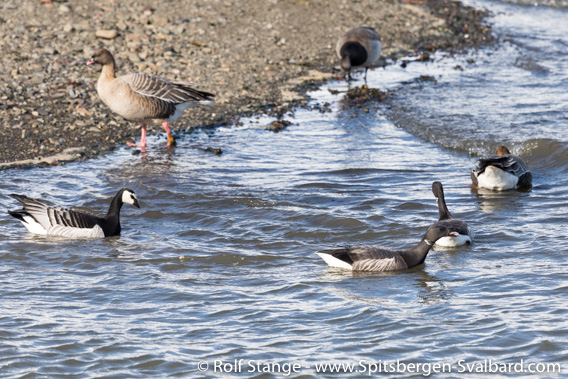
All three species of geese that breed in Spitsbergen in one photo:
Pink footed goose, Barnacle goose and Brent goose, Adventfjord.
I am almost a bit proud of this last photo that has all three species of geese that breed in Spitsbergen in one frame: Pink footed goose (upper left, not sharp), Barnacle goose (lower left) and Brent goose (lower right).
Housing market in Longyearbyen: avalanches and Airbnb
Housing market in Longyearbyen under pressure
The difficult housing market in Longyearbyen has been the subject on these pages already several times before. For years, it has been almost impossible to find an affordable place to live.
139 flats to be demolished
The situation got worse after the tragic 2015 avalanche, which killed 2 people in their homes and destroyed several houses. In the aftermath, a new avalanche risk evaluation was made for Longyearbyen. The shocking result is that houses with a total of no less than 139 flats have to be demolished, and avalanche barriers to secure remaining buildings are needed. A number of avalanche protections have already been built on the slopes of Sukkertoppen.
Further 41 fats at risk
Now doubts are coming up if it will actually be possible to secure some of the remaining buildings suffciently. The requirement is to build avalanche protection that is strong enough even for worst case scenarios of climate change – “business as usual” scenarios regarding future global CO2 emissions. In this case, foundations would have to go as deep down into the slope as 14 metres to make the barriers strong enough.
The question is if this is actually possible in the steep terrain. The answer is currently unclear. In the worst case, further houses with up to 41 homes will have to be removed, as reported by Svalbardposten. This concerns houses close to Sukkertoppen in Way 228.
Even though the result – demolition or not – is currently uncertain, one thing is for sure: the housing market in Longyearbyen will become even more difficult.
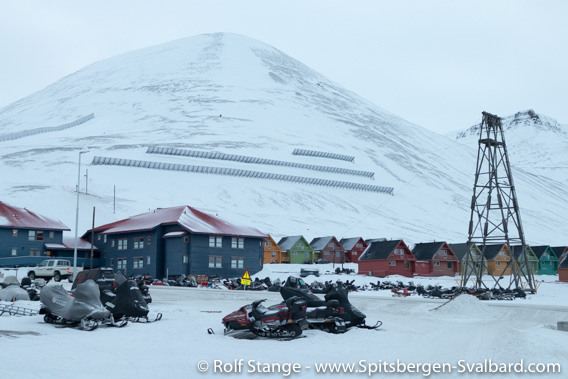
Residential houses, and avalanche barriers on Sukkertoppen.
Airbnb
Another factor which has caused public debate over years is the short-term rental platform AirbnB. It is no secret that a number of homes in Longyearbyen are rented out by their respective owners on short-term basis via Airbnb to tourists and not on long-term contracts to people who want to live in Longyearbyen. The actual number of homes that are lost this way for the housing market is not exactly known, but it is considered significant. When Svalbardposten recently researched the issue, 36 homes in Longyearbyen were offered on Airbnb.
More exact numbers are currently not available, so the community (Lokalstyre) has ordered a report from a specialised company to get more information about the influence of Airbnb on the local housing market. Depending on the result, the community could then consider limitations.
Airbnb is in the centre of public discussions linked to the housing market in many places in the world, but Longyearbyen may be more difficult than other towns: it is a small place with a small number of houses, where every loss makes a difference. There are many tourists with a lot of money, distorting the small and tight local housing market. Thirdly, you can not just move, settle down in the next village and commute.
One thing is for sure: it is currently almost impossible to find a home in Longyearben for smaller incomes.
Two persons dead in mountain accident in Hornsund
Two persons died during a mountain hike in Hornsund. They were a woman and a man who belonged to the crew of the Polish research station in Hornsund. They had set out for a private tour on Friday but did not return until the agreed time on Sunday morning, so the remaining station crew started a search.
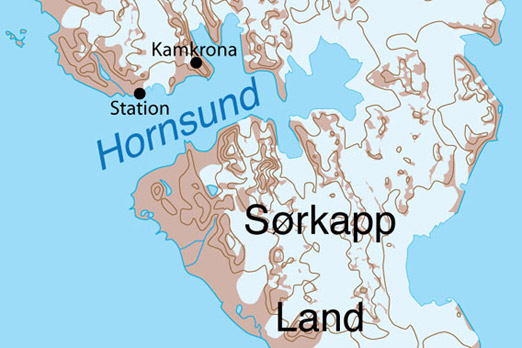
Map of Hornsund showing the research station and the mountain Kamkrona (accident site). © topographic base: Norwegian Polar Institute.
They had ascended the mountain Kamkrona, which is part of Sofiekammen, a long, steep ridge on the west side of Burgerbukta. Kamkrona is about 8 km east of the research station and 770 metres high, the east side of the mountain is very steep.

The mountain ridge Sofiekammen on the west side of Burgerbukta in Hornsund. Kamkrona is a peak approximately in the middle.
According to a press release by the Sysselmannen the two victims died during a fall of several hundred metres in an avalanche. No further details are public so far. The victims were recovered by SAR forces of the Sysselmannen and brought to Longyearbyen.
Update: According to Svalbardposten, Sysselmannen police officer Anders Haugerud told the Norwegian news agency NTB that the two appear to have stepped out on an overhanging snow bank on the mountain top. This was later confirmed.
As the families are informed, the names of the two deceased have been officially released. They were Anna Górska and Michal Sawicki. Both had been working at the station, Anna as meteorologist and Michal as geophysicist.
Spitsbergen website in Norwegian
This Spitsbergen website is now also online in Norwegian under the domain name www.spitsbergen-svalbard.no.
It is by far the largest and most comprehensive website dedicated exclusively to Spitsbergen – or rather: to Svalbard, because it covers the whole archipelago including the most remote corners. That is reflected by a large number of sub-sites covering all aspects of the geography, wildlife, and flora as well as the vast and still growing collection of polar panoramas where you can virtually travel all over Svalbard. News of international interest are included as well as a travel blog that covers all seasons and some insights into life in Longyearbyen … it’s all in there, in one website, with about 800 sub-pages and more than 1100 blog entries (per language!). I started working on the original German website www.spitzbergen.de in 2006 and the English version www.spitsbergen-svalbard.com followed soon.

This Spitsbergen website is now also online in Norwegian.
After Svalbard – Norge nærmest Nordpolen came out, it soon became clear that the website had to go the same way. This happend now after several months of intense work – now www.spitsbergen-svalbard.no is online. There are some English pages still hidden in there in a few places, their translation is still going on. Lucky if you find one 🙂
Big thanks to all who have helped to make this happen! This includes
Ida Elisabeth Aarvaag
Cecilie Bergheim
Marie Brekkhus
Mari Buck
Jannicke Høyem
Jesper Kirkhus
Tina Ottenheym
Aina Rogstad
Elisabeth Schoch
Veronika Sund
Ida Elisabeth Veldman
Ivar Våge
Tusen takk skal dere ha!
So for all Norwegian-speaking visitors to this website: enjoy reading and travelling Spitsbergen online in Norwegian on www.spitsbergen-svalbard.no!
Tundra swan near Longyearbyen
The swan song of the winter? Just in time for the “ornithological spring”, a rare tundra swan (Cygnus bewickii) showed up near Longyearbyen. Swans are not on the list of breeding birds in Spitsbergen, they come just occasionally as vagrants.
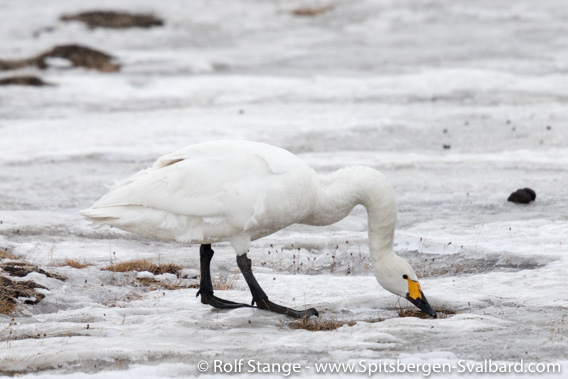
Tundra swan (Cygnus bewickii) in Adventdalen.
There are just five sightings of tundra swans registered on artsobservasjoner.no, a website to register species sightings in Norway. The oldest one of these observations is from 1987.
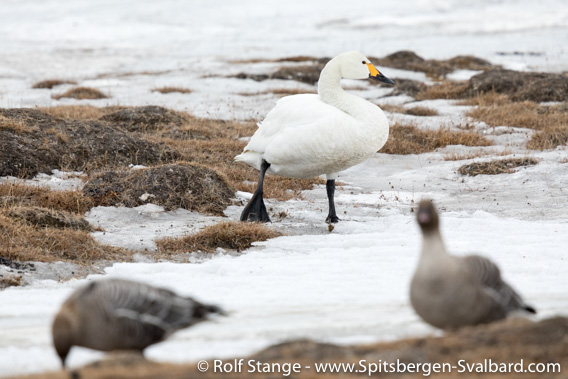
Tundra swan with pink-footed geese.
There are also sightings of the whooper swan (Cygnus cygnus) in Spitsbergen, 24 since 1992, including 7 observations from Bear Island (Bjørnøya). And regarding the tundra swan, things can actually be a bit confusing: according to Wikipedia, “The two taxa within it are usually regarded as conspecific, but are also sometimes … split into two species: Bewick’s swan (Cygnus bewickii) of the Palaearctic and the whistling swan (C. columbianus) proper of the Nearctic.”
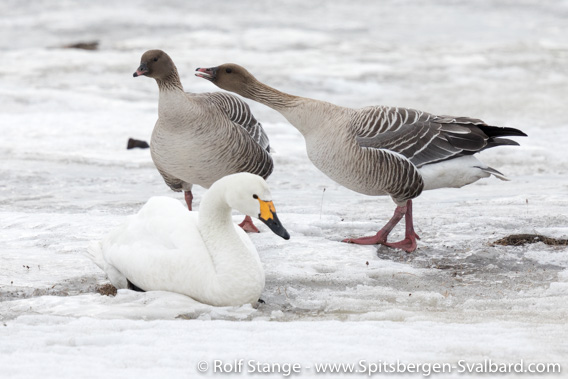
Tundra swan with pink-footed geese.
But in this case, local bird enthusiasts seem to have settled on a tundra swan (Cygnus bewickii). The bird seems currently quite happy amongst several dozens of pink-footed geese who came up during the last days after their spring migration.
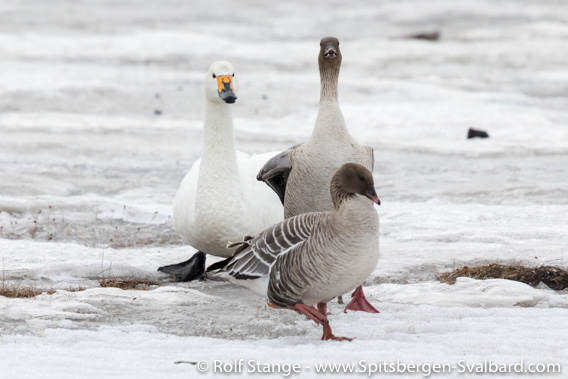
Tundra swan with pink-footed geese.
These photos were taken without disturbance with a focal length of 1200 mm and a high resolution camera.
Also these representatives of the local subspecies of reindeer seem to be happy that there are more and more patches of tundra coming through the snow now. The snow mobiles are stored away for this season, beast and man are looking forward to the summer now!
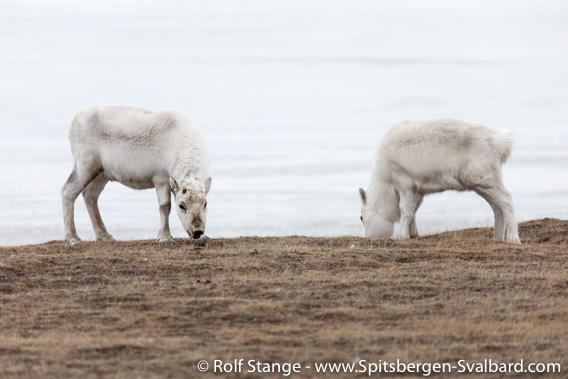
Reindeer on early snow-free tundra areas.
Newtontoppen
Thu
9 May
2019
The winter season is now, in early May or actually soon mid May, about to come to an end, but we are currently having beautiful days, after an April that was partly quite, well, mixed. Now we having temperatures below zero again – but not much, it is not too cold – and it is nice and sunny at times. Good reasons to get out there and enjoy the amazing ice- and snow landscape, once again in winter mode.
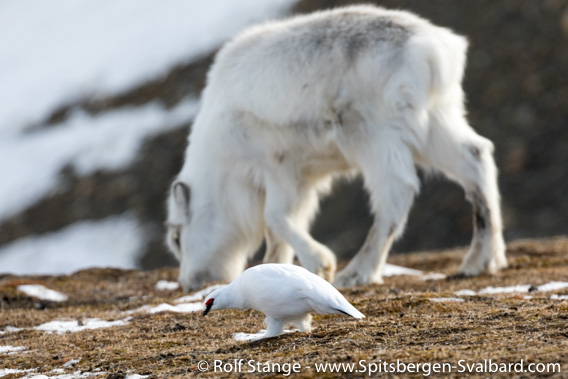
Spring is not far away anymore in Spitsbergen: Ptarmigan and reindeer are happy about spots of snow-free tundra.
We move rather efficiently trough the valleys to the east. Adventdalen, Eskerdalen and Sassendalen, one by one, like perls on a necklace. We leave them quickly behind, as we want to travel far this time.
At Rabotbreen we enter the wide glacier landscapes of east Spitsbergen. The huge moraine of Rabotbreen also shows signs of the approaching spring, icicles are hanging in small ice holes and caves. The sun is strong enough to make some ice melt even when temperatures are actually still below the freezing point.

Little ice cave in the moraine of Rabotbreen.
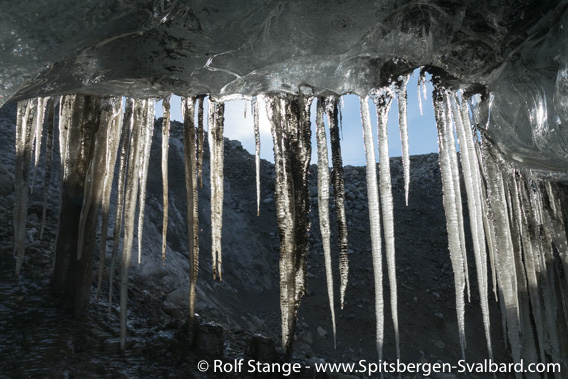
Icicles in an ice hole at Rabotbreen.
We leave also this interesting landcsape quickly behind us, and soon we turn north, deviating from the popular and beloved route across Nordmannsfonna towards Mohnbukta on the east coast. This time, we want to go further north.
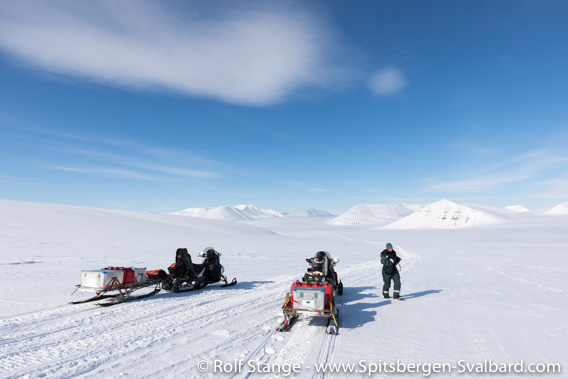
Heading north across Fimbulisen.
All we have around us is snow, ice and mountains. The landscape appears infinitely wide. Coastal and tundra landscapes have disappeared far behind us. Instead, there is one glacier after the other, one small ice cap neighbouring the next one. Well, they are not exactly small. Of course they can’t compete with those in Greenland and even Antarctica, but still, we are talking hundreds of square kilometres. Fimbulisen, Filchnerfonna, Lomonosovfonna … the latter one is the source to the mighty glaciers Nordenskiöldbreen and Mittag-Lefflerbreen. Lomonosovfonna is 600 square kilometres large!
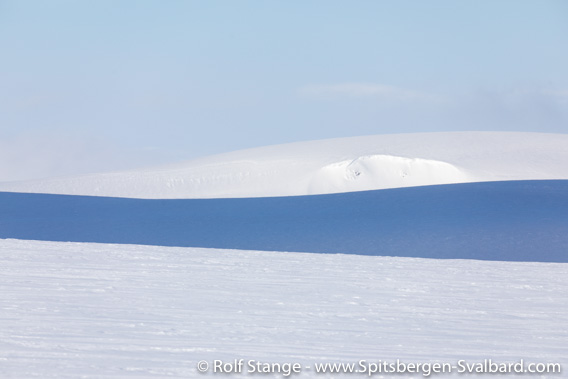
Infinite spaces: the ice cap Lomonosovfonna.
Our destination: Newtontoppen. This is Spitsbergen’s highest mountain, 1713 metres high. Or to be clear: the highest mountain of Svalbard, the whole archipelago. 1713 metres are, of course, not very impressive, compared to the large mountain ranges of this world. But it is far away … getting there is the first thing, and even on a lovely spring day like this, it is pretty cold.
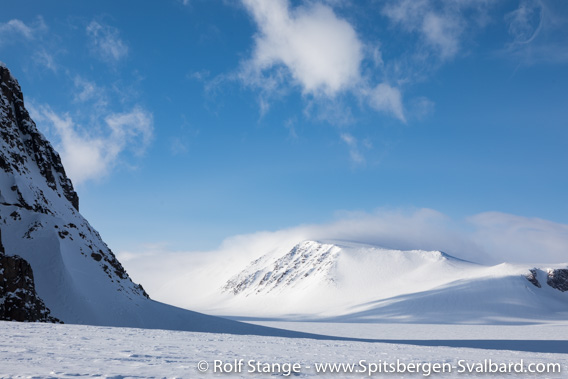
Newtontoppen comes into our view.
For me, it is the second tour to Newtontoppen. The first time was in 2010. Back then, the two of us used ski, pulk and tent, something that took us almost 4 weeks through this vast landscape. Today, we are faster.

Newtontoppen with a decorative cloud.
Back then, we were a bit more lucky with the weather on Newtontoppen: today, the top remains in a thin cloud, although it is largely fine and clear otherwise.
Newtontoppen is not a difficult mountain to ascend, it is “only” far away – and cold.
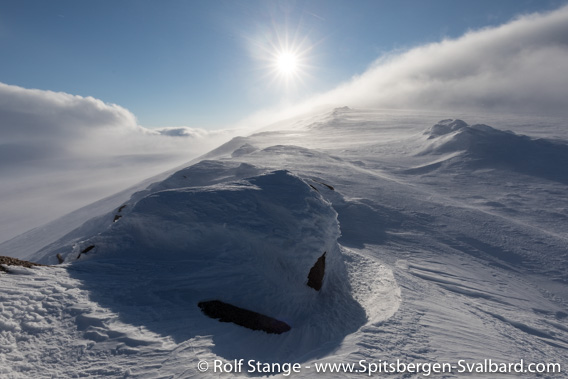
The top of Newtontoppen with clouds and stormy wind.
The wind on top of Newtontoppen is strong and it is ice cold, near -20 degrees of centigrade – plus windchill. So it is not exactly picnic time up here, but we enjoy being here, higher than anywhere else on Spitsbergen, for some moments.
And the view is clearing up just a few metres further down. There is a shoulder in about 1500 metres where the granite is coming to the surface. From here, we have got an impressive view over the surrounding mountains and ice fields.
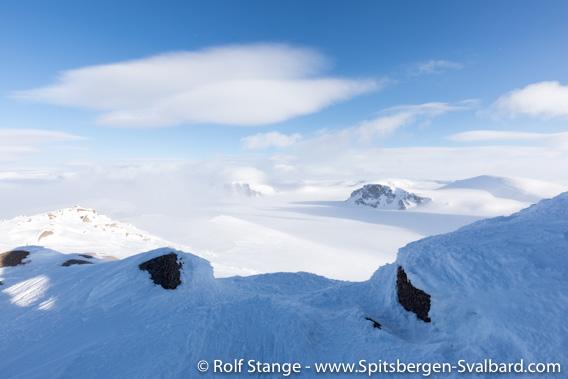
View from Newtontoppen to the south.
The way back home is a long one … more than 300 kilometres in total, from Longyearbyen to Newtontoppen and back.
Bank robbery in Longyearbyen: verdict
Spitsbergen’s first bank robbery took place in Longyearbyen on 21 December 2018. The offender was a 29 years old Russian citizen who had come to Longyearbyen a few days before. He threatened the bank employees with a rifle and forced them to hand out 70,000 Norwegian kroner (ca. 7,000 Euro) with the words “This is not a joke. This is a robbery”.
The man was soon arrested by the police and taken into pre-trial custody in Tromsø. Now the court, Nord-Troms tingrett, sentenced him to 14 months prison, as NRK reported. In addition, he has to pay NOK 20,000.00 to each of the 3 bank employees whom he had threatened during the robbery.
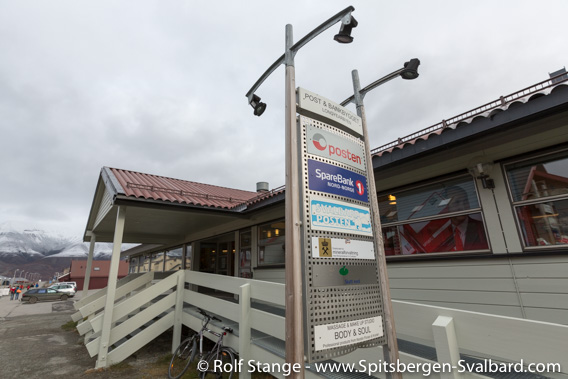
Bank robbery in Longyearbyen: offender sentenced.
Serious psychological problems are said to have played an important role. The man said that he had initially planned to commit suicide in Longyearbyen, but then decided to raid the bank in order to be arrested. It is also mentioned that he wanted to avoid having to return back to Russia.
The rifle that he had used during the bank robbery was loaded with sharp ammunition and the offender pointed it towards the bank employees. It was a bolt-action Mauser rifle, a very common type of rental weapon in Longyearbyen. After the robbery, the man went back to the rental shop with the rifle still loaded and returned the weapon. Then he went back to the bank to return the money, but did not succeed. Instead, he was soon arrested by the police. He did not offer reistance.
The sentence is below the claim of the public prosecuter, but higher than the defence lawyer had pleaded for. Revision is still possible.
News-Listing live generated at 2025/June/15 at 07:07:28 Uhr (GMT+1)




























